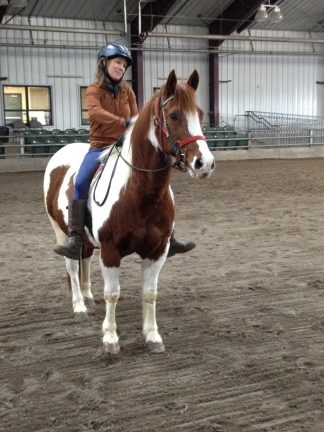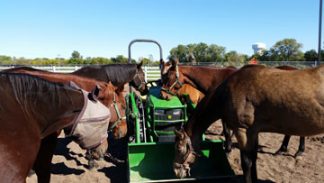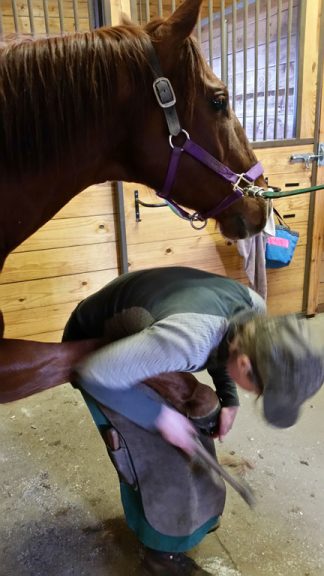What do you do?

Sue Penney, Barn Manager
I manage and care for a herd of 16 horses that are owned by the College of Veterinary Medicine. These horses are referred to as the “teaching herd” and are used by veterinary students in their clinical rotations as model patients. They are often the first contact a vet student has with horses, and they give the students an opportunity to learn how to perform basic physical exams, as well as more specialized exams (such as lameness, reproductive, respiratory, neurologic, gastrointestinal — to name a few) on a live animal.
These horses give students a chance to learn how to draw blood, perform radiographs, ultrasounds, and other diagnostic procedures. The horses are housed in a separate facility adjacent to the Leatherdale Equine Center (the “horse hospital”). The teaching horse facility consists of a 14-stall barn, three large paddocks with automatic waterers and shelters and one smaller paddock.
In addition to caring for the horses, I am responsible for maintaining the facility, making sure the barn is clean and in good repair, fences are intact, and water is flowing. I have a barn crew helping me with all this work, consisting of mostly students, a few volunteers, and some horse-loving types that just enjoy being around horses and getting a good workout. The most challenging and rewarding part of my job is the actual training of the horses to be good patients and kind to the vet students. I have a few troublemakers who like to test their boundaries, which makes my job (and theirs, I’m sure) more interesting. Horses like to have a job, so my crew and I do a lot of riding and groundwork to keep the horses active and focused.
A variety of tools for horse training

This is a very low-tech job. It is hands-on and physical.The tools I use most for barn and paddock maintenance are shovels, manure forks, and brooms. I also have an amazing little John Deere tractor that we use for some of the heavy lifting and dragging of arenas and paddocks.
Dragging is done with a harrow pulled behind the tractor. It is done to help keep the ground level and to break up manure piles so they decompose quickly. I have a variety of grooming tools, brushes, shedding blades, curry combs, hoof picks, etc. that are essential to keeping the ponies clean and looking their best.
For training and exercising the horses, we use a variety of equipment, such as lunge lines, — basically a long rope that attaches to the horse’s halter and is used to guide the horse in ground exercise. We have a variety of saddles and bridles — a properly fitting saddle is essential to a horse’s comfort, so we have saddles in several different sizes and types. Each horse that is ridden has their own bridle. Proper bridle fit and size and type of bit are also very important to their comfort and well-being under saddle.
One of my favorite pieces of training equipment is a rope halter with a long lead line attached that is slightly weighted to give more feel. The halter is very adjustable and has knots strategically placed to create pressure points for maximum control. We use this halter for new horses that are green (inexperienced) and/or young or that haven’t had proper basic training. It is very humane when used properly and is very effective in teaching the horse to yield to pressure and for the handler to communicate effectively with the horse on the ground.
Record keeping and schedules
For managing all schedules and my work flow, Google calendar and text messaging rules. For record keeping, we use three-ring binders, one for each horse, which contains all the pertinent information, captured on different forms. These include medical and farrier (hoof care) records, as well as vaccination and deworming histories.
These binders work for us because we have many different people — students, veterinarians, farriers, horse care workers — who contribute important records, and we need to have onsite access to all this information, in the barn and near the horses. There is no cable or WiFi in the barn, so we are, as I mentioned previously, very low tech. I have a vision of all this being digitized and stored in the cloud someday, but for now pen and paper gets the job done.

Farrier
Supporting future veterinarians
Looking at the larger picture and the broader goal of providing teaching support to vet med students, the horses themselves are the most important tool. They are so important in teaching our future doctors how to be doctors. Their role is important not only from an anatomical/physiological standpoint, but from a behavioral standpoint as well.
As herd animals and prey animals, horses experience a lot of anxiety when separated from their herd mates or in a strange environment. These horses teach our veterinarians how to have an effective and reassuring “stall-side manner” in a way that textbooks and lectures cannot. They have such an important role as teaching tools, and for that they are very much loved by faculty, staff, and students. We are so lucky to have them.
A note from the librarian:
Learn more about the U’s vet school and students by visiting their website. For more on the U’s work with horses and to read informative newsletters, watch videos and more, see the University of Minnesota Extension Horse program page. The Vet-Med Library has great resources on equine research.
—Ellen Engseth, Personal Information Management Collaborative member





